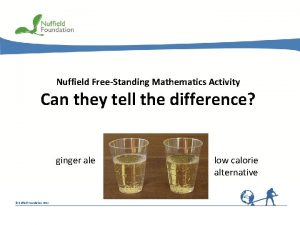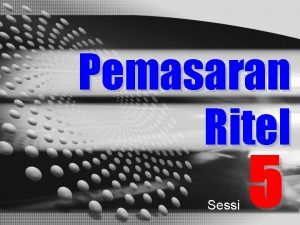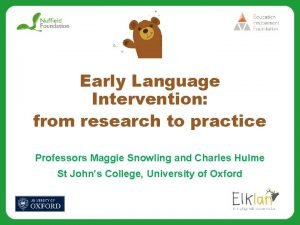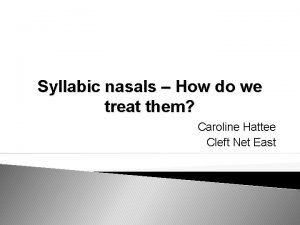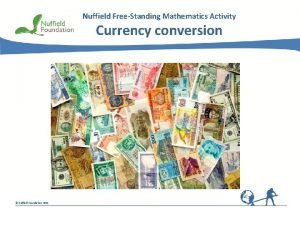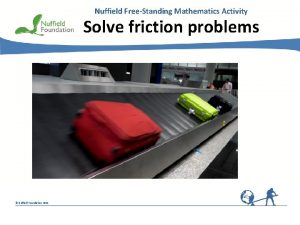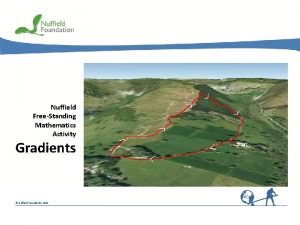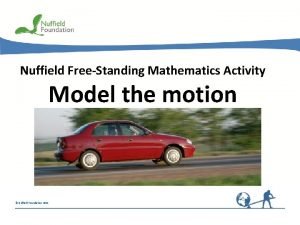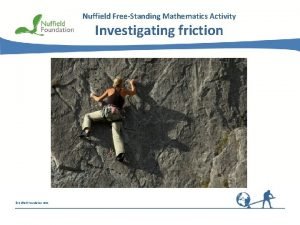Nuffield FreeStanding Mathematics Activity Can they tell the








- Slides: 8

Nuffield Free-Standing Mathematics Activity Can they tell the difference? ginger ale © Rudolf Stricker © Nuffield Foundation 2012 low calorie alternative

Food and drink manufacturers often offer an alternative product for customers who are very health conscious. Think about Can you suggest examples of this? They worry that customers may not buy the healthy option unless it tastes as good as the original product. Triangle tests can be used to find out whether people can tell the difference. In this activity you will carry out and analyse the results of a triangle test. © Nuffield Foundation 2010

Information sheet A What you will need to carry out a triangle test • a group of volunteers – check that they have no allergies Think about Why not in a line? • samples for each participant arranged in a triangle: 2 samples of the usual product + 1 sample of the healthier option • samples must look identical but marked in some way so you know which is which • a cup of water for each participant Think about Why is water needed? • a pen and instruction sheet for each volunteer © Nuffield Foundation 2010 Think about Why should you not label them 1, 2, 3 or A, B, C?

Instruction sheet Triangle test Thank you for taking part in this test which aims to find out whether people can tell the difference between a product and a healthier alternative. What to do Please take a drink of water before tasting any of the samples and also between samples. You may want to re-taste a sample, so do not consume the whole sample at once. Mark the sample that you think is different from the others. © Nuffield Foundation 2010 Think about How could you do this?

Information sheet B The triangle test Analysing the results using a 5% significance test Null hypothesis: H 0: participants cannot tell the difference probability of a person choosing the correct odd one out p = Alternative hypothesis: H 1: participants can tell the difference 1 -tailed test probability of a person choosing the correct odd one out p > Random variable X = number of participants from a group of size n who chose the correct odd one out © Nuffield Foundation 2010 Think about Assuming H 0, what type of distribution will X follow?

Information sheet B The triangle test Analysing the results using a 5% significance test Under H 0, X is Binomial with size n = the number in the group, p = and q = Think about What assumptions are being made ? Use this to find the probability of the test result, or better. Compare the total probability of the test result or better with 0. 05 If the total probability is less than 0. 05, the test result is significant. In this case, reject the null hypothesis and accept the alternative. © Nuffield Foundation 2010

Information sheet B The triangle test Example Suppose 8 out of 12 people identified the correct odd one out. Under H 0, X is Binomial with size n = 12, p = and q = Think about What probabilities should be added ? This is less than 0. 05. The test result is significant at the 5% level. Reject the null hypothesis. Conclusion: People can tell the difference between the products. © Nuffield Foundation 2010

Reflect on your work • Why do food companies use triangle tests? • Describe what you need to provide and how you should carry out a triangle test. • Did you have any problems in carrying out your triangle test? If so, how did you overcome them? • List the steps in the hypothesis test that you used to analyse your results of your triangle test. What did you conclude? • How would a 1% significance test differ from the 5% test? Would the result have been the same? • What limitations does a triangle test have? Can you think of any ways to improve it? © Nuffield Foundation 2012

